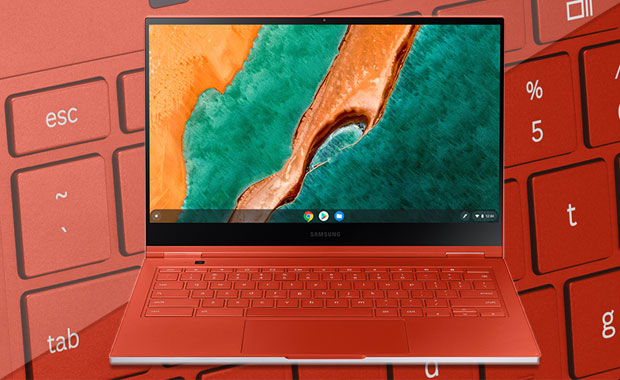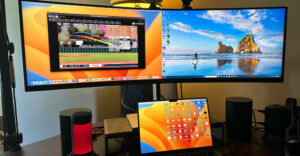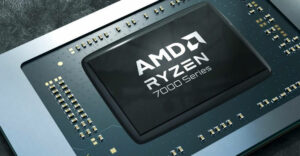The Samsung Galaxy Chromebook is now available to buy — but the US$999 price tag for its one-of-a-kind configuration may cause an internal struggle between want and need.
Samsung introduced its high-end Galaxy Chromebook at CES 2020 in Las Vegas early this year. The company positioned it as the flagship Chromebook to meet potential demand for a more useful and powerful multipurpose premium mobile device.
The Galaxy Chromebook is an ultra premium 2-in-1 laptop running Google’s Chrome OS. It ships with a durable aluminum body, the latest 10th Gen Intel Core i5 processor, and a 13.3-inch 4K UHD (3840 x 2160) touchscreen.
The Galaxy Chromebook enters a market packed with laptops that are getting thinner and faster each year. However, its appearance no doubt is ill-timed, given the COVID-19 pandemic. Only time will tell if the Galaxy Chromebook’s premium build and high-end specs will make it essential for consumers and businesses.
The comparative advantage to buying Chromebooks is usually their better battery life and more economical price — but not so much with this device, which functions as a clamshell laptop and swings into tablet mode via a set of 360-degree hinges.
Despite the Galaxy Chromebook’s stunning aesthetics, Mercury Gray or bold Fiesta Red color options, and packed configuration, it is up against two potentially demanding competitors — The Google Pixelbook and the Asus Chromebook Flip C436, according to reviewers.
Should serious Chrome OS users buy into this new unit? Generally speaking, no way, said Charles King, principal analyst at Pund-IT.
“Serious Chromebook users tend to focus on Web-based processes and applications that don’t require a ton of compute power or storage capacity, and have a strong preference for low-cost products with high-quality mobility features,” he told TechNewsWorld.
Samsung has delivered a pricey product that is long on luxury appointments (current gen Intel silicon, 4K display) and short on utilitarian features, especially battery life, King observed.
Worth the Price?
The one caveat is that the Galaxy would be a fine choice for those who use their Chromebooks for media and entertainment, have an electrical outlet nearby, and discretionary income to spare, King suggested. In general, though, the higher the price tag, the less sense Chromebooks make.
“The $999 base price of Samsung’s new machine is similar to above average Windows and Apple solutions. Anyone except serious fans of Samsung products will prefer the price and performance value prop of conventional laptops and convertibles,” he said.
Both consumers and business users are likely to react the same way toward the Samsung Galaxy Chromebook. Some might say that Samsung’s focus on visually striking design points make the Galaxy Chromebook an attractive “executive-class” solution.
“The Galaxy Chromebook is not, by any stretch of the imagination, a business solution,” King pointed out. “Its battery life and heat issues undermine that argument.”
Still, well-off consumers might be attracted to a classy looking convertible for home entertainment, Web browsing, Skyping, and social media, he admitted.
A Linux Reviewer’s Dilemma
The Samsung Galaxy Chromebook offers a stunning design and one of the best performance specs available. For Chromebook users, it very well could be the ultimate choice.
I enjoy a long-time love affair with the Linux operating system. I share my computing time with the Chrome OS. I have been waiting to get my hands on one since January when I first wrote about the pending release of the Samsung Galaxy Chromebook.
Do I really need all of those bells and whistles? I started out thinking I was ready to replace my two Chromebooks — an Asus that runs Linux apps just fine and a slightly earlier model not tooled inside for Linux.
I run Android apps on both of them and really want to step up to a higher-configured Chromebook with more internal storage and RAM. Despite the large capacity XD card in both of my machines, a major fail point for any Chromebook is the inability to save and run Android and Linux apps from the expanded storage.
I bided my time, fairly certain that the Samsung Galaxy Chromebook would be worth the wait. Now, considering the pros and cons brought to light in the initial round of reviews, I’m rethinking my purchase strategy.
I had put the Pixelbook on the back-burner. I was zeroing in the $800 Asus Chromebook Flip C436, first out of the gate with the latest configurations and hardware. Now I am weighing their merits against the Samsung Galaxy Chromebook.
The C436 would get me a Core i3-1011U CPU, 8 GB of RAM, a 128-GB PCIe solid-state drive (SSD), and a 1080p screen. Overall, that appears to be a nice trade-off between price, performance, and configurations.
The Samsung Galaxy Chromebook seems too magnificent to ignore. Many of the reviews on the just-released laptop are fairly consistent regarding its good and bad points. Most also agree it is pricey to a fault.
Too Much, Too Soon?
Despite it being the world’s thinnest Chromebook, it is total overkill, according to Dustin Vann, owner and CEO of
Trusy Social. It is packed with features but still not worth $999.
“It will raise the bar for Chromebooks — of that I have no doubt — but in turn it has raised the price by too much in my opinion,” he told TechNewsWorld.
For that price, you would expect more features and a level of compatibility that would come with a premium-priced laptop, Vann noted.
“The shallow keyboard reminds me of a gamer’s mechanical keyboard, which I’d suggest is not the demographic that would buy this computer,” he added.
Review Roundup
Samsung’s latest Chromebook does a lot of things right. The keyboard and screen are standouts, and it’s a very well-designed laptop, according to Nathan Ingraham, who reviewed it for Engadget.
It really feels like a successor to the original Pixelbook, he said. The Galaxy’s amenities include a gorgeous 4K touchscreen, a stowable pen, lots of storage and processing power, and a sleek, all-metal enclosure, “but for $999, its poor battery life is almost impossible to forgive,” he concluded.
The Samsung Galaxy Chromebook is “beautiful to a fault,” wrote Monica Chin in her review for The Verge.
Yet Samsung deserves credit for taking “a wrecking ball to what have traditionally been the two strongest arguments for buying a Chromebook,” she added.
Samsung clearly is pushing a different vision of what a Chrome OS product can be: a premium device for power users, Chin observed.
She praised the Galaxy Chromebook’s craftsmanship, noting that perhaps the best overall build feature is the stunning display, a 4K OLED screen. The vivid colors surpass the MacBook Pro’s look. Its glossy appearance contributes to the glare factor, though, not to mention the drain on battery life, she pointed out.
A glaring trouble spot is the Galaxy’s heat factor. Lacking a fan, the passive cooling system was often overcome, Chin found. With no fan, its passive cooling system allowed heat buildup that was noticeable on the aluminum chassis. That issue was not always present under heavy load, and even light use produced excessive warmth.
More Reviewer Insights
The price of the Samsung offering is overkill, wrote Taylor Kerns for Android Police — especially if you compare it to the lesser-configured Pixelbook Go starting at $350 less.
If you really have to have a higher-end Chromebook, the overpriced Samsung Galaxy “will get you a lot more bang for your buck” than the higher-end Pixelbook Go configurations costing $999 and $1,399, he noted.
Samsung’s Galaxy Chromebook is everything you could want in a laptop based on the Chrome browser, wrote Scott Gilbertson for Wired.
Price aside, there’s much to love, and it makes the most sense for hardcore Google product users, he added.
Those users live in Chrome, sync everything through Google Drive, post photos to Google Photos, and email from Gmail. From a hardware standpoint, Gilbertsonv admits to never having used a nicer Chromebook.
However, he did not see much value in the very costly laptop beyond the Google experience.
Comparisons Count
The Samsung Galaxy Chromebook does perform as strongly as the Chromebook Flip C436, according to Mark Coppock, who reviewed the Flip for Digital Trends.
The Asus Chromebook Flip C436 2-in-1 has relatively modern aesthetics with a small bezel and an 85 percent screen-to-body ratio, he pointed out. It comes with a dual-core, 10th-gen Core i3-10110U configuration with 8 GB of RAM and a 128-GB PCIe SSD.
The Asus Flip C436 is the fastest Chromebook in the Speedometer 2.0 benchmark, according to Coppock. Even better, for $200 more, buyers can get it with a quad-core Core i5-10210U configured up to 16 GB of RAM and with a 512-GB SSD.
The Chromebook Flip C436 is fast, well-built and earns its premium price, he wrote, and in that matchup, the Samsung Galaxy Chromebook finishes second best.
Final Thoughts
From my perspective, those specs make the Flip C436 a relatively close competitor if you do not dwell on the screen display technology in Google’s Pixelbook and the Samsung Galaxy Chromebook. Its battery life seems a tad bit better than what reviewers found in using the Samsung Chromebook.
After all is said and done, the Samsung Galaxy Chromebook may not amount to much more than a bigger, classier version of other tablet devices with the added benefit of a stylus. The embedded stylus in the Galaxy Chromebook is a great tool on the large, gorgeous screen in tablet mode.
Other than price, the big lingering concern that makes me hesitate to buy one is battery performance, which reportedly is poor. Samsung claims it can provide eight hours of battery service, but that is four hours less than I get now.
A number of reviewers said they got less than half of that. Of course, battery life depends on the user’s computing activities, and the high-end screen display is an unknown factor.
























































"Samsung Galaxy" usually has its top line peak product. Hopefully they might as usual have mid & low priced versions of these peak products.
Cost conscious users always have other brands & models to choose. When we old wise people need to assist our confused youngsters, which Chromebook do we suggest?
Chromebooks can have the power-hungry x86 Intel CPU. Or choose the power saving ARM CPU. With either CPU, large battery might assist with day long use. More than one USB-C port, allowing external hubs to be used is OK.
External hubs allow extra ports: USB, mSD or SD cards, HDMI, RJ12, 3.5mm, etc. Mine however have short cables, so may need extension cables.
Accidentally bought a compact netbook, with Intel I5 CPU. It runs Windows-10, heavy, expensive, power draining, hot, noisy (inbuilt fan) and therefore very impractical.
Now to buy a proper Chromebook. That runs Linux & Android.